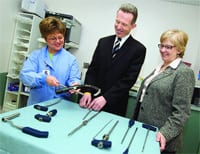Make It Count These 10 Mistakes Can Keep You from Reaching Your Full Fitness Potential
Have you been going to the gym on a regular basis and not achieving the weight loss goals you dream of? Fitness success can be wrecked by many different things. It seems there are always better things to do than work out. But being fit is a lifelong journey. It just does not occur overnight. If someone tells you it does, run in the other direction because it’s a scam.
If your fitness results are not where they should be, then you are more than likely falling victim to one of 10 mistakes that can keep you from achieving your health, fitness, and weight-loss goals. Simply begin implementing one or two of the strategies outlined here, and watch the changes start to occur.
Lack of planning. This is the most common problem I find among busy professionals (that includes stay-at-home moms). They become so consumed with all the daily activities that they do not schedule any time for themselves. I find using a weekly scheduling book works wonders. One night each week, write out your weekly plan. Put yourself in as an appointment — in pen, not pencil! Give yourself ample time to spend a minimum of 30 minutes working out. If you are saying, “that’s easier than it sounds,” well, you are right. But evaluate your entire day, and you are surely doing two or three activities that are non-productive to your health that require sitting for longer than 30 minutes. Give up 30 minutes of TV, for example, three times per week, and this will get you headed in the right direction.
Unrealistic expectations. So many people that I meet on a daily basis have completely false expectations of what 20 minutes of exercise three times per week should do to their body. Keep in mind that everyone will respond differently, but only a tiny percentage of people can do less than five to six hours of physical activity a week and expect to have the body they want. If you look at the girl in the bikini at the grocery store magazine rack and expect to get that body by walking three times per week, let me tell you, it is not going to happen. Sit down with a professional and find out what is realistic for you and your time commitment.
Undefined goals. There has to be a final destination in sight in order to attempt to get there. If you have no defined goals, you will spin your wheels for years without success. Goals need to be written down and frequently revisited. They need to be posted in a place where you can see them often. And they may change over time as you reach certain milestones.
No initial measurements besides the scale. I see so many clients come in and hop on the scale on a daily basis. They gain one pound and beat themselves up about it until the next time they jump on the scale. When you start a weight-loss or fitness program, you must have beginning body-composition measurements taken. If you do not know your muscle-to-fat ratio, you are missing out. Your goal with any weight-loss or fitness program should be to build calorie-burning lean muscle and burn unwanted fat. Find a coach to do your beginning measurements, then re-check on a monthly or six-week basis.
Starting out too aggressively. No matter what your fitness level start out slow, and increase the work load over time. Most of the time, when people begin exercise programs, they go after all the results in week 1. They are at the gym for 12 hours that first week. But by overdoing it the first couple of weeks, they become overly sore, fatigued, and do not get the result desired. So they reflect back on week 1 and think there is no way they can keep that pace. And what usually happens is that people get frustrated and quit.
If you begin your program slow and work up the intensity, you will eliminate all the deep soreness and the feeling of being so broken down. You will give your body more time to adapt to the changes and may actually see an increase in energy in week 1. Progressing slowly allows the muscles and joints more time to get used to having an increased load placed on them. In order to truly know where you need to start with your program, I advise hiring a fitness professional who can design a program specifically for you.
Not using resistance training. Resistance training stimulates muscle growth, which in turn increases your calorie- and fat-burning ability. The more muscle you have, the better at burning fat you will be. If you can add two pounds of lean muscle to your frame, you can burn approximately 70 to 100 more calories at rest. The phrase ‘grow more muscle’ usually freaks women out. But adding muscle is the secret to losing body fat long-term. Muscle is your fat-burning furnace, and resistance training is the only way to build lean tissue. Your program must be ever-changing and challenging enough to stimulate the muscle, and use all major muscle groups on a weekly basis.
Doing too much aerobic exercise. People usually think of aerobic exercise in conjunction with losing weight. Aerobic exercise is a very important part of the weight-loss equation, but it’s not the magic bullet. In fact, when you do too much aerobic activity, your body will burn muscle for fuel instead of fat. When you burn muscle for fuel, you actually make yourself fatter, which is obviously counterproductive if your goal is long-term weight loss.
There are many ways to go about doing aerobics, but one of the best for fat loss is interval training with periods of high intensity followed by low-intensity intervals. Aerobic sessions can be anywhere from 20 minutes to 60 minutes depending upon your fitness level and your goals. If you do this for the majority of your cardio sessions, you will see results faster than by spending countless hours on the treadmill with no purpose.
Cutting carbohydrates from the diet. Cutting carbohydrates is usually done to lose weight quickly. But most of the weight you lose with carbohydrate restriction is water. This is one of the diet centers’ favorite tricks to take your money; in truth, water weight loss means nothing in the overall scheme of things. If you stay on a low-carb diet long enough, your body will adapt and become efficient at converting amino acids for energy. This is counterproductive because we need our amino acids to help the muscle-building process.
Carbohydrates are protein-sparing nutrients. Simple carbohydrates are things like fruit, crackers, chips, and some cereals. Complex carbohydrates are things like vegetables, beans, and sweet potatoes. Our bodies must work harder to break down complex carbohydrates; therefore, we have fewer calories for storage. Complex carbohydrates also help control blood sugar more than simple carbohydrates. Any time you can eat a complex carbohydrate as opposed to a simple one, this will help your weight-loss efforts. But do not cut carbohydrates out of your daily plan altogether; they are your body’s main source of energy — and we all want more energy.
Not eating enough protein. Protein intake is the missing ingredient for most folks. Protein is what your body uses for repairing tissue after a hard workout (or daily life). Protein is made up of amino acids, which are like little carpenters coming to work at night when we sleep to rebuild our muscles. This muscle is what raises our metabolism. Protein is vital for weight loss.
So the big question is, how much protein do we need? For active people, a good place to start is multiplying body weight by 0.7. This is the amount of protein you should eat in grams per day. For example, a 150-pound person should eat 105 grams per day, or 21 per meal over a five-meal day. If you have trouble maintaining or gaining muscle with this amount of protein, then you can add accordingly.
Not getting enough sleep. Last but not least is proper rest. When we consistently exercise, our bodies must have time to repair. Sleep is when most of the repair process occurs. If you do not get the recommended seven to eight hours of sleep per night, you are cheating yourself of some hard-earned muscle development. Protein rebuilds our muscle tissue, and this process occurs when we are sleeping. Our body must also reset its endocrine system (hormones), which is also done during deep patterns of sleep.
One of the most frustrating things that occurs in a weight-loss plan is a plateau before reaching your ultimate goal. I have worked with clients in the past who are eating healthy foods, performing consistent resistance-training sessions, and undertaking the right amount of aerobic activity, and still see minimal change. The one thing these clients usually have in common is poor or inconsistent sleep patterns. When you get seven to eight hours of sleep per night, your results will shine through. If you are having trouble sleeping, then try to avoid caffeine late in the day, read a book before bedtime, or listen to a relaxation CD prior to falling asleep.v
Coach Holly Leonard, owner of BeFit Health and Wellness Solutions, is a body transformation expert who has helped more than 300 Pioneer Valley men and women reclaim their health, fitness, and vitality through proper fitness and nutrition. For more expert advice, log onto www.yourbodyfixnow.com today.


